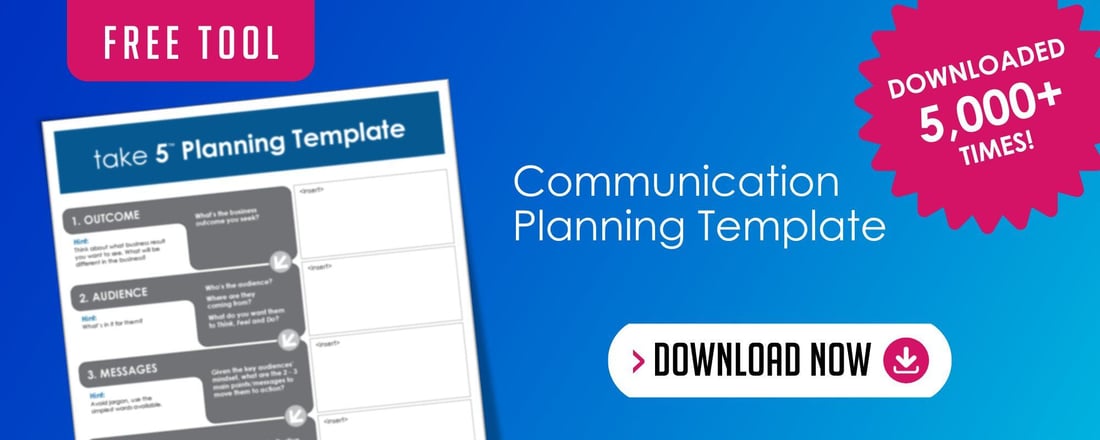
We’ve established that leaders are always communicating—even when they don’t realize they are. It’s fair to say that 80 to 90 percent of the average leader’s week is spent communicating. Yet, how much time are those same leaders spending on planning for those communications, and thinking about the messages that they send? That’s more like 10 percent.
It’s a fact that leaders are used to putting time and energy into business plans, product launches, business succession plans, and more, but when it comes to planning for day-to-day communications, most fall down on the job. As I like to say, the Nike slogan, “Just Do it!” doesn’t apply here. You can wing it and take a chance on your results, or you can make a plan and significantly increase your impact.
 Being more purposeful in your communications can take as little as five minutes. To help give yourself a jump start, download our popular Take 5™ Planning Template. Use this template to map out your communication—whether it’s to one person, a group or an organization. Click here to get started.
Being more purposeful in your communications can take as little as five minutes. To help give yourself a jump start, download our popular Take 5™ Planning Template. Use this template to map out your communication—whether it’s to one person, a group or an organization. Click here to get started.Information Does Not = Communication
Information and communication are not the same. Information is just words; communication is about moving people to action. There are four components that distinguish communication from information. In order to truly communicate, you must:
- Understand your audience
Adjust your message to best match your audience. Communicate to them, not just to anyone. You also shouldn’t just share data; you need to shape information in a way that has meaning for a particular audience. Think of it as the difference between a bookkeeper printing out financial reports for you, and a controller or CFO interpreting the data into critical information that is important to help you understand or make decisions. - Engage your audience
Involve them to get their respect, interest and attention—not to mention great ideas. Ask questions and use empathy to convey sincerity. - Be truthful and direct
You must have respect for people so that they will reciprocate that respect and buy in to your communications. - Plan your method for communicating
Email is not the best way to communicate. Face-to-face, whether in person or virtually, “live”—whatever you want to call it, this is best when communication is about a tough issue or is a tough message. And, remember, there’s no winging it—every communication, even those that are in person, needs to be strategic, prepared for and planned.
In what ways do you plan your communications?
—David Grossman
Plan your communication—whether it's to a colleague, your team or company-wide—in as little as 5 minutes. Click the image below to download your copy of this free tool—Take 5™ Planning Template—today!
Tag(s):
Leadership Communication
Other posts you might be interested in
View All Posts
Leadership Communication
5 min read |
March 8, 2021
How to Effectively Plan Your Next Communication in 5 Minutes
Read More
Internal Communication
5 min read |
May 24, 2021
7 Good Reasons to Measure Communications in Your Organization
Read More
Leadership Communication
5 min read |
July 18, 2022


Comments on this post